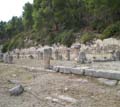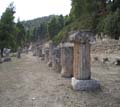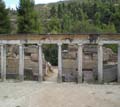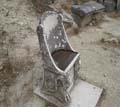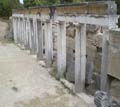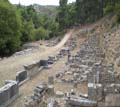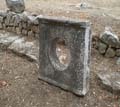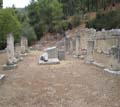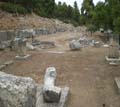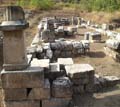
Many prehistoric sites and tombs from the Mycenaean era (3rd - 2nd millennium BC) have been identified in the surrounding hills. In today's Skala Oropou, a geometric settlement and the ruins of an early Christian basilica on the beach were excavated. Famous and crowded was the Amphiarion, sanctuary of the hero Amphiaraus. This is where patients used to seek treatment with the method of hypnosis, i.e. the healing help of the god in their sleep. The sanctuary is located on the banks of a stream in a dense pine forest. It was founded by private individuals at the end of the 5th century BC. In its center springs the sacred spring, from where, according to tradition, Amfiaraos emerged. Amphitheater square and altar to its north, as well as a men's bath. Next to it, the foundations of the Doric temple of Amfiaraos (4th century BC) were excavated. The largest building of the sanctuary is a stoa (middle of the 4th century BC. X.) which served as a "burial ground" for patients. To the west of the portico are 25 pedestals of statues, mostly from Roman times. Also famous was the theater of the sanctuary with a restored proscenium and five marble thrones in place (after 200 BC). Hostels, women's baths, workshops and shops, market, marketplace and a hydraulic clock (hourglass) were also excavated. In the local Archaeological Museum various architectural members and various kinds of offerings to the sanctuary are exhibited. There is also a rich collection of inscriptions. Early Christian marble reliefs and architectural members in second use in various temples in the area. Also famous was the theater of the sanctuary with a restored proscenium and five marble thrones in place (after 200 BC). Hostels, women's baths, workshops and shops, market, marketplace and a hydraulic clock (hourglass) were also excavated. In the local Archaeological Museum various architectural members and various kinds of offerings to the sanctuary are exhibited. There is also a rich collection of inscriptions. Early Christian marble reliefs and architectural members in second use in various temples in the area. Also famous was the theater of the sanctuary with a restored proscenium and five marble thrones in place (after 200 BC). Hostels, women's baths, workshops and shops, market, marketplace and a hydraulic clock (hourglass) were also excavated. In the local Archaeological Museum various architectural members and various kinds of offerings to the sanctuary are exhibited. There is also a rich collection of inscriptions. Early Christian marble reliefs and architectural members in second use in various temples in the area.
Source: MINISTRY OF THE AEGEAN
media.yen.gr/atlas











